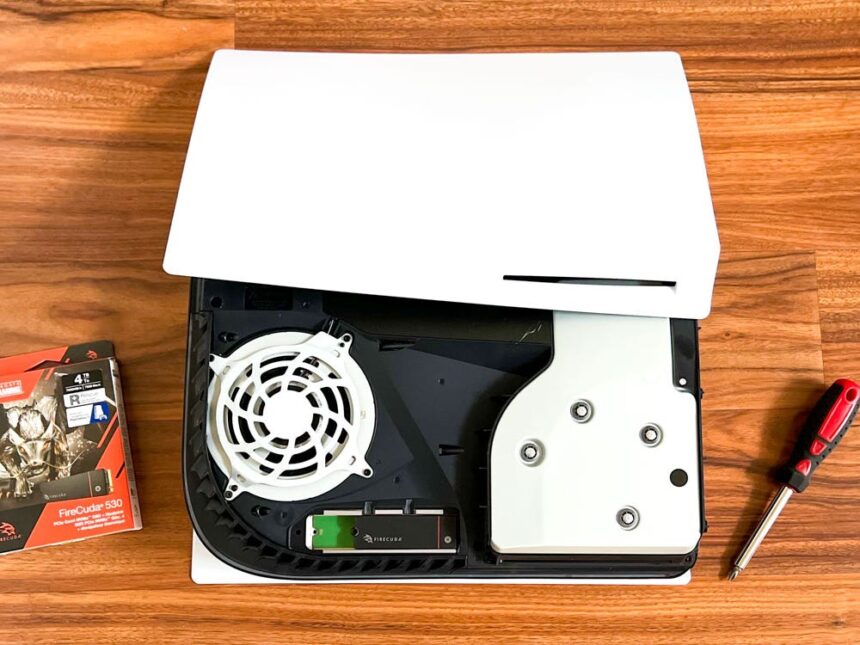The PlayStation 5 is one of the most powerful gaming consoles ever created, and much of its magic comes from the ultra-fast solid-state drive built directly into the system.
This SSD is what makes lightning-fast loading, seamless transitions, and near-instant game booting possible. But as any avid gamer knows, the PS5’s internal storage fills up quickly, especially when blockbuster titles can take up more than 100 gigabytes each.
That is why expanding your storage with a compatible SSD is not just a luxury anymore; it has become an essential upgrade for players who want to enjoy their games without worrying about constantly deleting old titles.
Choosing the right SSD for PS5, however, is not always simple. Between technical specifications, heatsink requirements, pricing differences, and real-world performance, the process can feel intimidating.
This guide is designed to walk you through the details step by step, helping you make an informed choice while offering practical tips you can apply in your gaming life every day.
Why the Right SSD Matters
The PS5 was engineered around speed. Sony’s internal SSD is not just storage it is part of the console’s core performance engine.
That means when you decide to expand your system, you cannot just buy any SSD off the shelf and expect it to work.
The console requires specific standards in order to maintain the fluidity and responsiveness you are used to. If you purchase a drive that doesn’t meet the requirements, you may run into long load times, overheating issues, or even complete incompatibility.
This is why Sony issued very clear guidelines about what type of SSD can be installed, and understanding these specifications is the first step in making the right decision.
The difference between a compatible SSD and a random one can be dramatic. A proper NVMe drive that meets PS5 standards will allow your games to load in seconds, textures to render instantly, and updates to install without bottlenecks.
On the other hand, a slower drive could cause noticeable lag and even disrupt your overall gaming experience. Since most people are investing not just in storage but also in future-proofing their system, the right SSD truly does matter.
Understanding the Minimum Requirements
Sony has outlined a set of requirements that every PS5-compatible SSD must meet. While these specifications might sound highly technical at first glance, they are actually straightforward once broken down.
The drive needs to be an M.2 NVMe SSD that uses PCIe Gen4 technology. It must achieve a minimum sequential read speed of 5,500 MB/s, which ensures that data moves quickly enough to keep pace with the PS5’s demanding architecture.
The form factor also matters; the drive should be M.2 2280 or similar, which describes its physical size and slot compatibility.
One critical detail many first-time buyers overlook is the need for a heatsink. Because the PS5’s SSD operates at such high speeds, it generates significant heat. Without proper cooling, the drive may throttle itself, reducing performance, or in extreme cases, sustain damage.
Some manufacturers sell drives with built-in heatsinks, while others require you to install one separately. Either option is acceptable, but skipping the heatsink altogether is a mistake you should avoid.
For practical application, whenever you browse SSD options online, make it a habit to read the product description carefully.
Look for clear mention of PCIe Gen4 x4 interface, 5,500 MB/s or faster speeds, and heatsink compatibility. If the manufacturer claims “PS5-ready,” double-check reviews and official benchmarks before believing the label.
Many brands use marketing buzzwords that can mislead customers. A quick comparison to Sony’s published requirements can save you money and disappointment.
Popular SSD Choices That Gamers Trust
Among the SSDs that consistently earn praise for PS5 use, a few names stand out. Samsung’s 980 PRO with heatsink is a favorite because of its reliability, excellent firmware, and strong brand reputation.
Western Digital’s WD Black SN850X is another excellent choice, offering top-tier speed and great thermal design. Corsair’s MP600 Pro LPX is appreciated for its slimmer heatsink, which makes installation easier, especially if you are worried about space inside the console.
Seagate’s FireCuda 530 is often called one of the fastest options available, boasting impressive durability ratings that appeal to hardcore players who game for hours every day.
While these examples are frequently recommended, the market continues to evolve. New models emerge, sometimes offering lower prices for the same performance or bundling in additional features like free software or extended warranties.
For gamers, the trick is not just to buy what everyone else is buying but to evaluate how the drive matches your budget, your long-term needs, and the amount of storage space you realistically require. A two-terabyte drive might sound attractive, but if you primarily play a few core games, a one-terabyte option could be more cost-efficient.
Why Internal Expansion Beats External Storage
Many PS5 owners wonder if they can just plug in an external SSD and avoid the internal upgrade altogether.
While external storage can certainly serve a purpose, it does not unlock the same potential as an internal expansion. External drives connected via USB are excellent for archiving games you are not actively playing, but they cannot run PS5-native titles directly.
This is because external connections simply do not reach the same speed thresholds required by the console’s architecture.
By contrast, an internal SSD expands your PS5’s storage in a way that makes it indistinguishable from the built-in drive. Games load instantly, performance remains consistent, and you never have to worry about moving files back and forth to free space.
If you value convenience and speed, internal expansion is far superior. Of course, external storage still has a role if you like to maintain a library of older PS4 titles or want a backup solution, an external SSD or HDD is perfectly fine.
But when it comes to enhancing your PS5 experience, internal storage is where you should focus your investment.
Installation Made Simple
Upgrading your PS5’s storage may sound like a job for a technician, but Sony designed the process to be relatively straightforward. Once you have the right SSD, the process takes only a few minutes. You begin by turning off the console and removing the side panel, which reveals the expansion bay.
A small screw holds the cover in place, and once it is removed, you can slide the SSD into the M.2 slot. After securing it with the screw and replacing the cover, the console will recognize the new drive when you power it back on. At that point, the PS5 will prompt you to format the SSD, preparing it for use.
The installation process is not only manageable but also safe, provided you take a few precautions. Always unplug your console before opening it, avoid touching the exposed circuits of the drive, and handle the components with clean, dry hands.
If your SSD did not come with a heatsink pre-installed, make sure to attach one carefully before sliding it into the slot. After installation, the PS5’s software handles everything automatically, ensuring that your new storage integrates seamlessly with the system.
Everyday Tips for Optimizing Your SSD
Once your SSD is installed, the journey doesn’t end there. Keeping your drive in top shape requires a few habits that will benefit your console in the long run. Start by keeping your PS5’s system software updated, since firmware improvements can enhance compatibility and performance.
Some SSD manufacturers also release their own firmware updates, which you can apply by connecting the drive to a PC before installing it in your console.
Heat management should also remain a priority. Place your console in a well-ventilated space, avoid enclosing it in tight cabinets, and clean dust filters regularly.
These small steps keep both the console and SSD running smoothly. Another useful tip is to manage your game library efficiently. Instead of storing dozens of games you rarely touch, archive older ones to external storage or re-download them later from your library.
This prevents unnecessary strain on the SSD and ensures faster navigation when browsing your collection.
Daily habits like pausing large downloads to improve speed or enabling Rest Mode for overnight updates can also make a difference. Gamers who take care of their SSD enjoy consistent load times, fewer performance hiccups, and longer hardware life overall.
Balancing Price, Capacity, and Warranty
Storage upgrades are an investment, and finding the right balance between price and performance is key. While larger capacities provide more convenience, they also come at a premium.
For many players, a one-terabyte drive strikes the best balance, offering plenty of room for major titles without breaking the bank.
Those who play a wide variety of games or prefer not to delete anything may consider two or even four terabytes, though the cost rises significantly.
Warranty coverage is another factor to weigh. Reputable manufacturers often provide five-year warranties or endurance ratings that guarantee a certain amount of data writing over the life of the drive.
This assurance adds peace of mind, especially when you are investing in hardware that will see daily use for years to come. By comparing not only the sticker price but also the long-term value and support, you can make a smarter decision that pays off over time.
Reliable Sources and Further Reading
For those who want to dive deeper, Sony’s official PlayStation site provides a detailed guide on how to install an internal SSD in the PS5.
Reputable tech review outlets such as Tom’s Hardware and Digital Foundry regularly publish benchmarks of the latest SSDs, giving you insight into real-world performance beyond the manufacturer’s claims.
Manufacturer sites, like Samsung’s 980 PRO page or Western Digital’s SN850X page, also provide valuable technical information and warranty details.
On our own blog, we also cover broader PS5 optimization strategies, from choosing the best gaming headsets to setting up your console for streaming. By interlinking these resources, you can explore not just storage expansion but also every aspect of enhancing your gaming lifestyle.
Choosing the best SSD for PS5 is about more than just adding storage. It is about preserving the high-speed, seamless experience that defines the console.
By understanding Sony’s requirements, researching trusted brands, balancing capacity with budget, and applying good maintenance habits, you can enjoy a gaming setup that feels both expansive and reliable.
Installation is simple, the benefits are immediate, and the investment ensures that your PS5 remains future-ready for the growing demands of modern gaming.
When done correctly, this upgrade transforms your console, giving you freedom to download and play without hesitation.
The right SSD is not just hardware; it is a gateway to more immersive sessions, less waiting, and more gaming joy.

